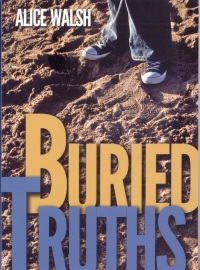| ________________
CM . . .
. Volume XIX Number 41. . . .June 21, 2013
Buried Truths is the story of 14-year old ZoŽ, who is sent to live with a father she never knew after the woman she thought was her mother dies. It is set in Port aux Choix, NL, where ZoŽ gradually discovers who her family is at the same time as she participates in an archaeological dig looking for evidence of Maritime Archaic Indians. Mike is her father, someone she always believed to be dead. Mike, his wife Sarah, and their adopted daughter Laura welcome ZoŽ into their home, and ZoŽ gets a summer job working at the dig where Sarah works. ZoŽ meets Mikeís parents: Opa, who is kind and supportive, and Ans, who ZoŽ is suspicious of because she thinks Ans wanted her mother to get an abortion. ZoŽ makes friends with Abbey, a girl her age also working on the dig, and Josh, a good-looking neighbouring boy. ZoŽ has to revise her opinion of her father and his family: she always believed they had driven her mother away when she got pregnant out of wedlock with Mike, but now she finds out her mother lied to them and told them she had a miscarriage. Trying to understand why her mother would want to keep ZoŽ from her father, ZoŽ reads the journals that her aunt sends her. She is confused when she reads about her mother having an abortion, and horrified when she reads, "I have killed my own child and stolen another." ZoŽ believes this means she isn't actually related to Mike and his family. She makes a drunken spectacle of herself at Mike and Sarah's anniversary party and then runs away. Opa sends Josh to go find her and invites her to stay with him. At her grandfather's house, ZoŽ sees a picture that makes her realize that the woman who raised her was not her real mother. Her real mother had died when she was a baby, and her friend, instead of informing her father, claimed the baby as her own, since she had aborted her own child. While ZoŽ is living with them, Sarah has a hysterical pregnancy because she is barren and seeing Mike's biological daughter was too difficult for her to deal with. ZoŽ ends up living with her grandparents, who accept her no matter what her genetics are. At the end of the story, ZoŽ uncovers an artifact that definitively proves the existence of Maritime Archaic Indians at this site. The plot of Buried Truths is contrived. The truth about ZoŽ's mother is unconvincingly complicated. The archaeological dig is a metaphor for uncovering truths about the past, but mostly it is a vehicle for conveying information about prehistoric peoples of Newfoundland. At times, this can feel didactic and stilted. Most of the characters are well-developed, particularly the adults; they have realistic motivations and reactions. ZoŽ's relationships with Abbey and Josh could be fleshed out more: adolescent readers would be interested to know how Abbey and ZoŽ became friends and would probably rather know more details about Josh holding her hand than about Paleoeskimo tools. References to Shakespeare's The Tempest are woven throughout the text, in quotations at the beginning of each chapter, in a performance that Opa directs, and in the restaurant The Tempest. They develop themes of deceptive appearances and the truth about families. The most touching moments in the book are when ZoŽ realizes the true affection of her father and grandparents. The plot of Buried Truths is contrived. The truth about ZoŽ's mother is unconvincingly complicated. The archaeological dig is a metaphor for uncovering truths about the past, but mostly it is a vehicle for conveying information about prehistoric peoples of Newfoundland. At times, this can feel didactic and stilted. Buried Truths works best when it shows a girl finding a place to belong. It is less compelling as an introduction to Newfoundland archaeology. Recommended with reservations. Kim Aippersbach is a free-lance editor and writer and mother of three in Vancouver, BC.
To comment
on this title or this review, send mail to cm@umanitoba.ca.
Copyright © the Manitoba Library Association. Reproduction for personal
use is permitted only if this copyright notice is maintained. Any
other reproduction is prohibited without permission.
NEXT REVIEW |
TABLE OF CONTENTS FOR THIS ISSUE
- June 21, 2013.
AUTHORS |
TITLES |
MEDIA REVIEWS |
PROFILES |
BACK ISSUES |
SEARCH |
CMARCHIVE |
HOME |
